The FiiO M11S is a DAP (Digital Audio Player) that has been standing out in the market of portable music players due to its cost-effectiveness. Currently, aside from the Tempotec v6 ($371), the M11S ($449) is one of the cheapest players with support for installing music streaming apps we have. For this reason, it has been the choice of many who prefer to use a DAP over a “dongle” (portable USB DAC/amp), and there is even a text where the differences between these two types of devices were discussed.
The reason why a $400 player is such a good value for the money these days is due to the fact that below that price, companies have chosen to only offer “dongles” (USB DAC/amp) for their customers to listen to their music using their smartphones, which no longer have a P2 output (3.5mm). As the audio quality delivered by a “dongle” is already able to match DAPs in the range of US$100 to approximately US$300, the companies decided to focus on the development of DAPs that cost around US$400 onwards, as according to themonly in this price range would it make sense to purchase a player considering its features.
FiiO M11S: Best value for money for streaming DAPs?
Today, consumers of products in the $100-$200 range don’t care much about features and are looking for something that delivers great audio quality for a low price. However, for those who want something dedicated to music and, at the same time, support for music streaming applications, the FiiO M11S is an interesting alternative.
FiiO M11S: Build and features
The construction of the FiiO M11S impresses when you take it in your hand. With a 5″ IPS LCD screen with a near borderless 1280×720 (720p) resolution, album cover images don’t seem to need anything with a quality beyond that.

FiiO takes great care with the player’s finish, where machined aluminum painted in black was used in most of its body and a glass back, making it really beautiful in my opinion.
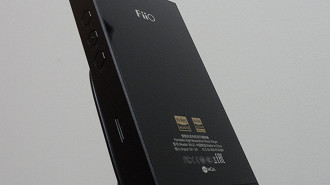
Thinking about 271g, the M11S isn’t as light as a cellphone, but there’s a reason for that. This player is capable of delivering an output power of 670mW (4.3V) at 32 Ohms when connecting a headphone with a 4.4mm or 2.5mm plug. This requires more space both for the audio circuit, which features 3 headphone output options (3.5mm, 2.5mm and 4.4mm), and for the 5300mAh battery that this model has.
Because the output power of a DAP like this is considerably higher than that of a smartphone, the battery life of the M11S is just 14h. Duration is based on playing a file in MP3 format, high gain (1)keeping the screen off and the equalizer off
(1) The FiiO M11S has a gain selector divided between low, medium and high. This is used to get more control over the volume steps when using a more sensitive headset, such as an in-ear, or a more demanding headset, such as a headphone.
As mentioned above, the M11S has 3 outputs for headphones, the 3.5mm unbalanced, with lower output power, and the 2.5mm and 4.4mm balanced. (2), delivering the maximum power of the player. This opens up the possibility of achieving better performance with both more sensitive headphones and more demanding models. But if this DAP is still not enough, it is possible to use the line outputs (3) to connect it to a dedicated desktop amplifier’s connections, which can be either RCA (unbalanced) or XRL (balanced).
(3) There is more than one line out (LO or line out) on the FiiO M11S. There was the implementation of a single-ended line output (SE or unbalanced) and a balanced line output.
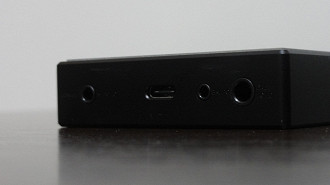
Another possibility to obtain a quality even higher than that offered by the M11S is using the digital connections to connect it to a dedicated desktop DAC. You can connect the player via a coaxial cable or a USB cable. Personally, I find it easier to get a USB cable for this purpose, where the DAP will work only as a player (transport) and the audio signal will be converted and amplified out of it, as there will be a DAC, to convert the digital signal to analog, and an amplifier, to amplify the signal.
It is interesting to note that in the scenario above, you can use the FiiO Music application to control the DAP through your cell phone, offering greater practicality in the case of using this resource in a speaker system, where the listener is further away from the sound system. audio. If it’s a headphone system, I think it’s more comfortable to control everything through the M11S itself, where there are physical buttons for controlling the music and a screen for browsing and viewing the cover art of the album being played.
Entering the commands part, it is important to mention that FiiO has implemented a double-click system on the physical buttons for when the user has not touched the player for some time. This is to avoid accidental touches when putting the DAP in your pocket and picking it up awkwardly. That is, if you want to “play/pause”, it may be necessary to press the button for this function twice in a row.
You can also control how the DAP power management will be done, avoiding possible interference.
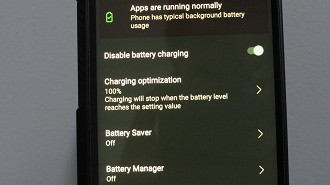
You can change the bitrate transmitted by the Bluetooth LDAC audio codec to get a more stable connection and consume less battery at the same time.
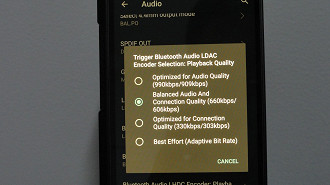
In terms of storage, the DAP comes with 32GB of internal storage, although 16GB are occupied by the operating system and other base files. However, fortunately it is possible to use a micro memory card of up to 2TB capacity.
(2) Article “When can you use the balanced output of a DAP, dongle or DAC/amp”
FiiO M11S interface and applications
Even with all the benefits mentioned above, those interested in buying DAPs like the FiiO M11S always want to know about the user experience of the interface and applications on the player. After suffering a lot with older DAPs, I can say that this new generation of FiiO players manages to deliver a fluidity comparable to cell phones when browsing music streaming applications. Of course, there will be some that will be a little slower, as is the case with Amazon Music, but this is already seen even on smartphones.
The M11S operating system is Android 10 and using the Snapdragon 660 chipset and 3GB of RAM memory, I can say that the experience in applications such as Spotify, Tidal, Apple Music and YouTube Music is very fluid. I didn’t experience any choking when browsing the apps and playback only stopped when there was a problem with the Wi-Fi connection. Unfortunately the DAP antenna was not so good at capturing the Wi-Fi router signal from the places where I used the device, sometimes the signal varied between medium and full, although it was rare to get a “weak” signal.
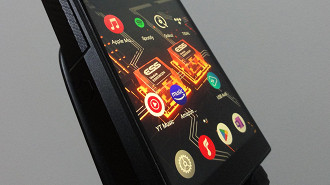
As for the fear that some people have of running out of support for streaming app updates, it’s important to keep in mind that in the case of Android 10 this will take time. In 2022 WhatsApp announced that it would end support for cell phones with Android 4.0.4, which was released in 2011. To better position ourselves, in 2022 Android 13 was launched by Google, while Android 10 debuted in 2019.
Which headphones is the FiiO M11S suitable for?
I believe, based on my experiences, that the FiiO M11S is more suitable for using in-ear, earbud and on-ear headphones (4), i.e. portable formats. Although it has the ability to “push” some headphones, I recommend using amplifiers or DAC/desk amps for this situation. Of course, if the user wants a little portability to take their headphones to different places, nothing prevents using this player for this purpose, depending on the headphone model, as in most cases the result will not be terrible.
My advice for not using headphones with the M11S is for those who want to squeeze as much quality out of the headphones as possible. However, I understand that there are people who are willing to sacrifice some of that headphone potential to get the portability of an audio system with this DAP.
(4) Article “What types of headphones exist”
Conclusion
The FiiO M11S has excellent navigation performance through the operating system, streaming applications and local music playback apps (FiiO Music). In addition, its output power should be enough for the vast majority of portable headphones, whether in-ear, on-ear or earbud. It is important to remember that its proposal is not limited to that and the various resources that this and other players have compared to “dongles” (portable USB DAC/amp) must be taken into account.
